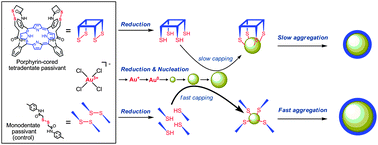An in situ quick XAFSspectroscopy study on the formation mechanism of small gold nanoparticles supported by porphyrin-cored tetradentate passivants†
Abstract
We previously reported that a

* Corresponding authors
a
Department of Molecular Engineering, Graduate School of Engineering, Kyoto University, Kyoto 615-8510, Japan
E-mail:
tanakat@moleng.kyoto-u.ac.jp
Fax: +81-75-383-2561
Tel: +81-75-383-2558
b Kyoto University Pioneering Research Unit for Next Generation, Kyoto University, Kyoto 615-8510, Japan
c
Department of Molecular Chemistry and Biochemistry, Doshisha University, Kyotanabe, Kyoto 610-0321, Japan
E-mail:
yhitomi@mail.doshisha.ac.jp
Fax: +81-75-585-6096
Tel: +81-774-65-7437
d Japan Synchrotron Radiation Research Institute, 1-1 Kouto, Sayo-cyo, Sayo-gun, Hyogo 679-5198, Japan
We previously reported that a

 Please wait while we load your content...
Something went wrong. Try again?
Please wait while we load your content...
Something went wrong. Try again?
J. Ohyama, K. Teramura, Y. Higuchi, T. Shishido, Y. Hitomi, K. Aoki, T. Funabiki, M. Kodera, K. Kato, H. Tanida, T. Uruga and T. Tanaka, Phys. Chem. Chem. Phys., 2011, 13, 11128 DOI: 10.1039/C1CP20231F
To request permission to reproduce material from this article, please go to the Copyright Clearance Center request page.
If you are an author contributing to an RSC publication, you do not need to request permission provided correct acknowledgement is given.
If you are the author of this article, you do not need to request permission to reproduce figures and diagrams provided correct acknowledgement is given. If you want to reproduce the whole article in a third-party publication (excluding your thesis/dissertation for which permission is not required) please go to the Copyright Clearance Center request page.
Read more about how to correctly acknowledge RSC content.
 Fetching data from CrossRef.
Fetching data from CrossRef.
This may take some time to load.
Loading related content
